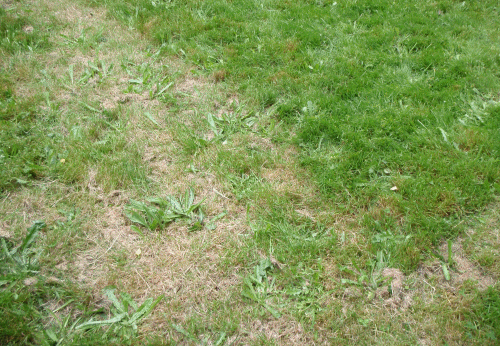Thank you for this site. It is a little bit of heaven.

I purchased my home several years ago and I am still dealing with the previous (original) owner's misguided
gardening techniques. Her rules: Miracle-grow on everything at least once a week.
Water the grass every day. Amend everything with peat moss and
wood ashes. Make sure if you plant something new, plant it no further than a foot from something else. If your sumac branches split, lots of duct-tape and an old yellow broomstick will fix it right up. If your glads and iris fall over, pound a 16 penny nail into the siding and tie them up with the ugliest yarn or wire you can come up with. OMG! Warning: Not the best of ideas! Bless her heart.
It took 3 years to get rid of the sumac
trees and the suckers from their well spread
roots.
The
lawn had used up all 2 inches of the pathetic commercial "sandy loam" and had grown thatch 3 to 6 inches deep. The lawn was barely rooted in the brown dirt, below the thatch. I could actually score the turf and lift it up like a carpet. I was out of town for over a month a couple years ago and paid a neighbor kid to water the lawn. He took shortcuts. The turf died and the subsequent winter it rotted into a peaty consistency. In the summer it shed water better than DWR. After years of trying to save it I de-thatched it but good--With a sod cutter! I could go on forever. My apologies.
It is reported to rain-all-day-every-day here in Western Washington. Well, that is except for the 6 or so weeks of summer when it does not rain a drop.
Earthworms were rare and grubs were plentiful. It took almost 3 years to get the earthworms back under the lawn and in the beds.
For the most part, I have stripped the lawn since it rotted and I am composting it, all 3200 sq. ft. of it. It was itself turning into a peat like mess, so it had to go. While it reduced in volume somewhat, it still remains at about 25 cubic yards in volume. Much of it is what remains of the sandy loam, devoid of nutrients, that were spread originally. There are some clumps of the thatch remaining. I intend to incorporate this material somewhere in the mix.
The original grade was too steep for a good garden due to run-off so I re-graded it. I’m in the process of completing a retaining wall.
My existing dirt is the brown, rocky, Pacific Northwest
native fill. A water/mason jar sediment test of my soil shows much sand and very little organic matter (< 1/16"). I purchased a truck load of
local fill dirt wich was gray and had a higher clay content than mine. I think that dirt may not be the best for this
project.
I am an avid residential composter with only 1/3 acre to work with. Thus, I can only
compost so much. Though, I am very successful with hot and cold composting. I also chip and shred with a little Bearcat 5.5 (b&s) shredder.
Since I am able to start from scratch, I want to do the best I can.
I have about 12" to 18" yet to bring up to grade on an area of about 2800 sq. ft.
When my wall is complete I need to bring in the remaining bulk materials to bring it up to grade. I will put in some grass and beds. I want to ensure proper drainage and water retention along with a good ecosystem for the beneficials to dwell. I do not intend to use petro-chemicals in this project.
It is obvious to me that I
should bring in some more fill, and then begin mixing/tilling in varying degrees of OM until I get to the final grade. I know how potato sized rocks seem to sprout continuously toward the end so I would like to finish with a screened product to complete the last several inches.
Any ideas on what the optimum finish to this should be? Such as, "Bring the fill up to the last "X" inches and start tilling in "X" inches of "X" OM material and finish with "X" inches of "X" mix."
Additionally, how much will this settle? Keep in mind that the Pacific Northwest is a quirky marine climate unlike most any other. Also, I live on the Kitsap Peninsula which makes my bulk suppliers of quality materials limited or increases my delivery fees.
Silverdale Slug



















































